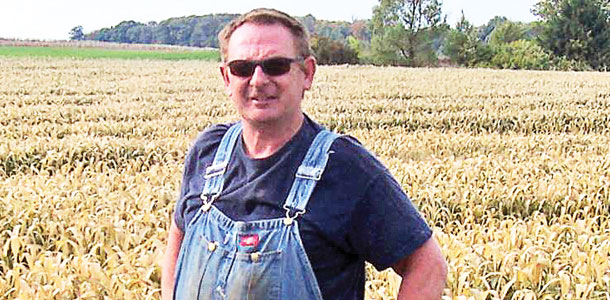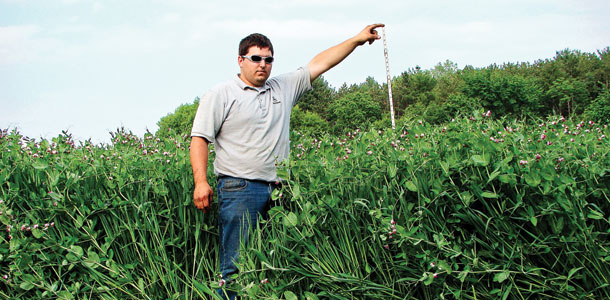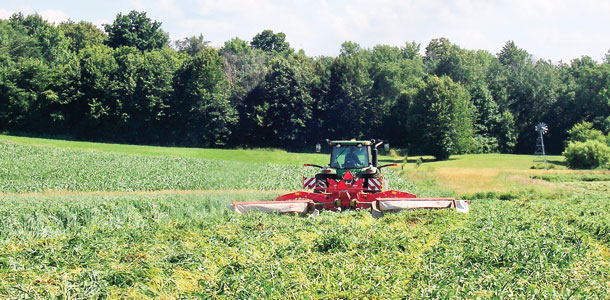As he tills and cultivates fields for his annual crop rotations, Richard Kratz also sows the seeds of innovation. It took four years to perfect his blend of peas and oats, but he is now literally reaping the benefits from Kratz Farm’s 2,000 acres. And, like pollen carried on the breeze, word of the breakthrough is spreading.

Kratz Farms is a Wisconsin Certified and Pro Seed Genetics dealer and dairy farm located in Slinger, Wisconsin. Now in its seventh generation, the partnership of three brothers and one brother-in-law milks approximately 500 cows. With some recent developments in crop management, they have not purchased feed from outside sources in 10 years.
“We were always a big believer in trying to grow all of our forages and keep as much stuff in-house as possible so we can control the costs of it,” Kratz says. “If you are buying byproducts to try to feed animals, you know what your costs are today, but you won’t know what they will be two months from now because of the swings in the market.”
The main product Kratz is using is green mix, a combination of peas and oats cultivated in both the spring and fall. The variety of oats used is Forage Plus. First developed at the University of Wisconsin – Madison in 1990 and rights bought by Kratz and five other private farmers, the crop is characterized by a high dry matter yield and good crown-rust resistance.
But the factor that has helped Kratz increase his crop yield the most is the oats’ delayed maturation, reaching the harvest stage five to seven days later than other varieties. This made it a perfect pairing for Arvika peas, a tall plant and also a late-maturing variety.
“The peas will be budding so we can have the highest protein levels we can get, and the oats will be at boot stage, which will be the best feed quality the oats will be able to give you,” Kratz explains.
In the spring, this delayed growth allows the blend to be used for cover-cropping alfalfa, the three plants growing concurrently at different rates. In mid-April, 100 to 120 pounds of green mix and 15 to 18 pounds of alfalfa are planted per acre. The oats and peas are harvested in late June, one month before the alfalfa is ready for cutting.
In 2014, green mix yielded 6.5 wet tons of forage. After $20 in planting costs, $48 for planting and $110 in harvest fees, the extra crop returned $137.44 in profit on land for which seasonal rent was already paid. Cover-cropping also helps to crowd out weeds, reducing the need for herbicides, and prevents soil washout.
Higher-testing oats and peas are cultivated in the fall as a double crop with wheat. After wheat harvest in the beginning of August, manure is added to the soil followed by 120 pounds of green mix.

This can be gathered as late as the beginning of November since the crops are less susceptible to frost than sorghum, surviving up to eight hours of exposure to freezing temperatures, according to Kratz. Additional benefits to this system include restoration of phosphorous balance and an increase in organic matter.
“We are still getting to harvest the crop on top, because most of your organic matter comes from the root system,” Kratz says. “So as tall as the plant gets, there is about as much of a root system underneath the crop.”
The only downfall to the fall mix, Kratz adds, is that its proliferation is highly dependent upon rainfall. In 2014, the farm projects yield to be 4 wet tons per acre.
The spring-harvested peas and oats are fed to heifers and dry cows. Their protein content is high enough to eliminate the need for soybean additions. Kratz feeds the fall crops to lactating dairy cows.
Research by Ken Albrecht, an agronomist with the University of Wisconsin – Madison, has shown that late-planted oats have higher feed values from greater accretion of water-soluble, rapidly digested carbohydrates than those grown earlier in the year. Kratz attributes this to a longer, slower growth.

In 2013, Kratz Farms shipped 50,000 bags of green mix mostly in wholesale markets. The seeds are grown by farmers as far east as New York and as far south as Texas.
The farm also markets a white mix Arvika pea and Trical T2700, triticale wheat-rye hybrid, mainly to farms without dry cows or heifers, as well as a number of wheat varieties. Kratz and his partners are also currently developing their own tall-growing winter wheat.
Kratz hopes to show others the value of his cropping system. He believes that the number of dairies cultivating their own crops is growing due in large part to a demand for quality control and utilization of waste. Double-cropping and cover-cropping with green mix has proven that producers can grow more on the same amount of land, increasing productivity from the ground up. PD
Learn more about Kratz Farms at their website.
Holly Drankhan is a senior at Michigan State University with plans to attend vet school. She is a 2014 Progressive Dairyman editorial intern.
PHOTO 1: Double-cropping a pea and oat mix for fall and springimprove forage supply over sorghum, which is limited by early frost.
PHOTO 2:Kratz Farms employee Jerry Becker stands in a sorghum field planted for fall harvest. Note the limited plant height, thin density and yellow coloring due to an early frost.
PHOTOS 3 and 4:Double-cropping a pea and oat mix for fall and spring cultivation has provided high yield and quality for the dairy at Kratz Farms (PHOTOS THREE and FOUR), improving forage supply over sorghum, which is limited by early frost. Photos courtesy of Katie Kratz.






